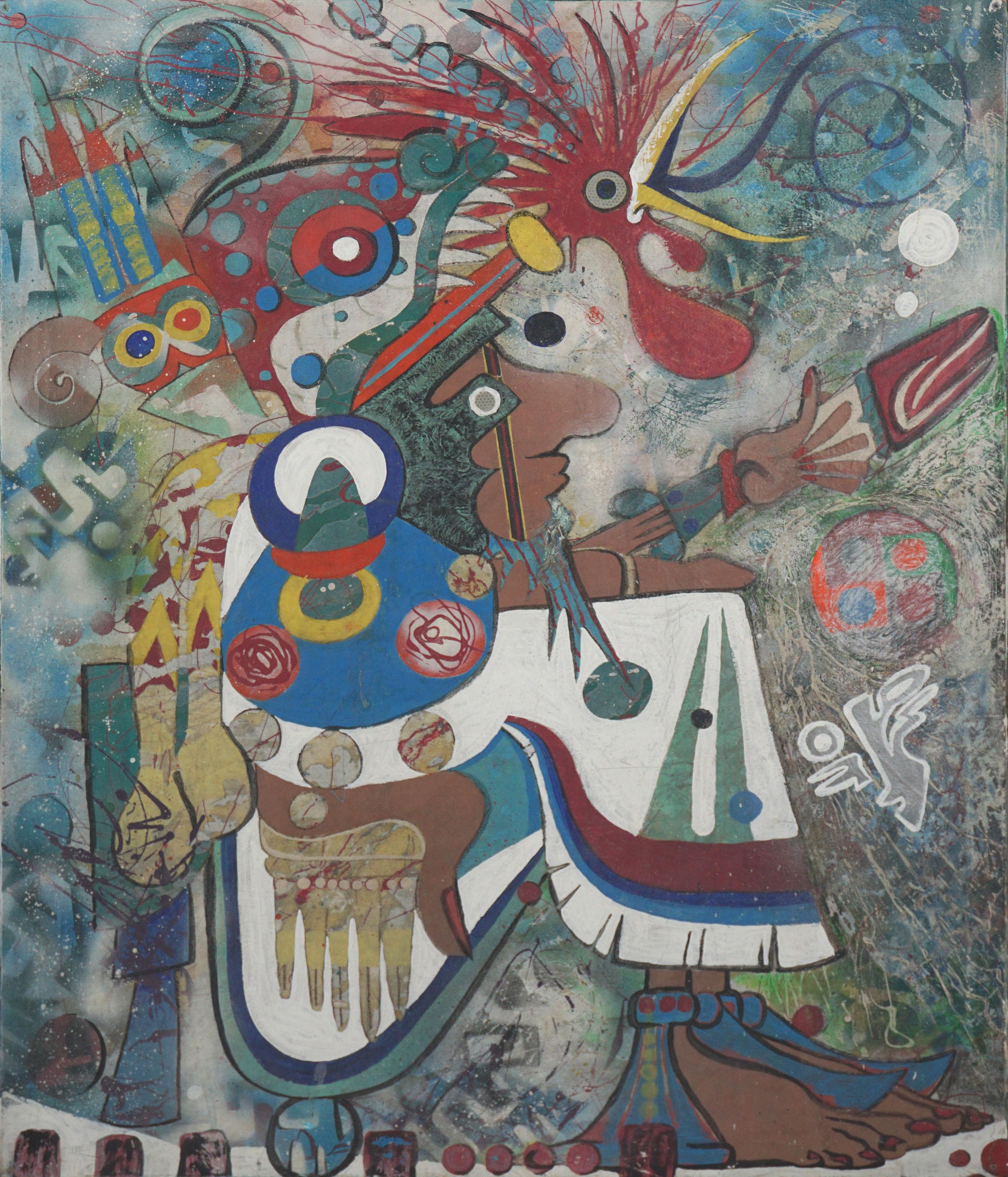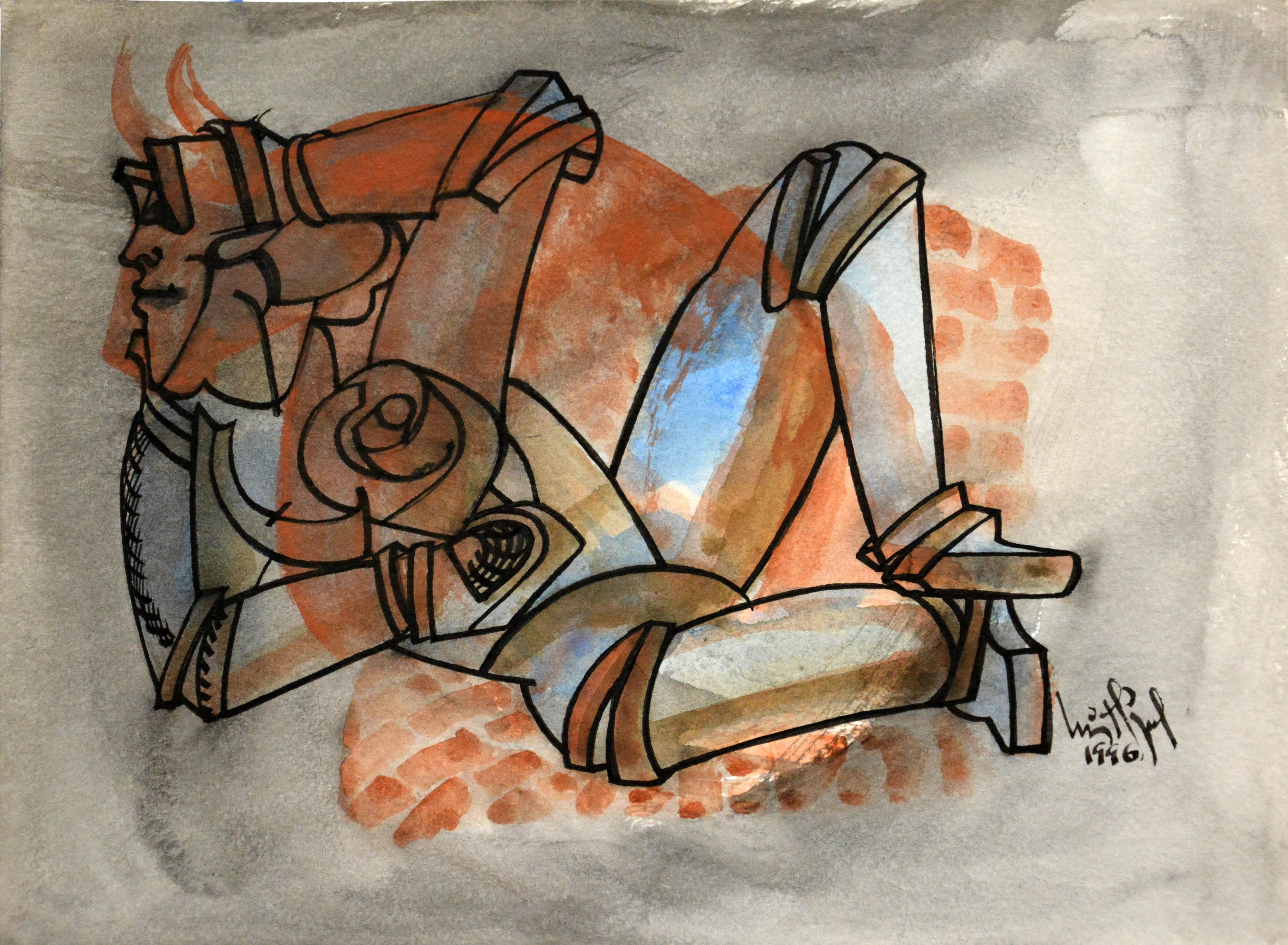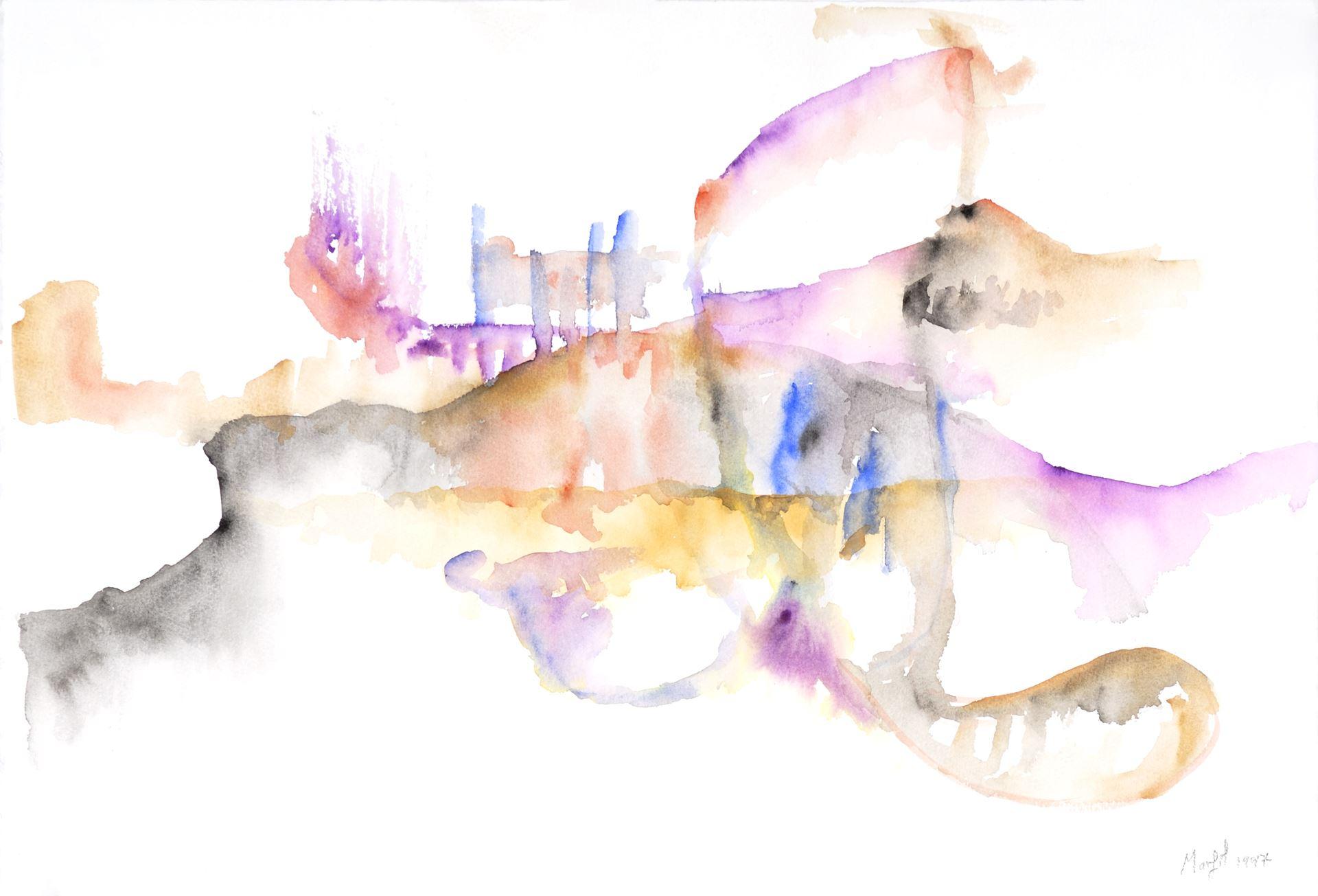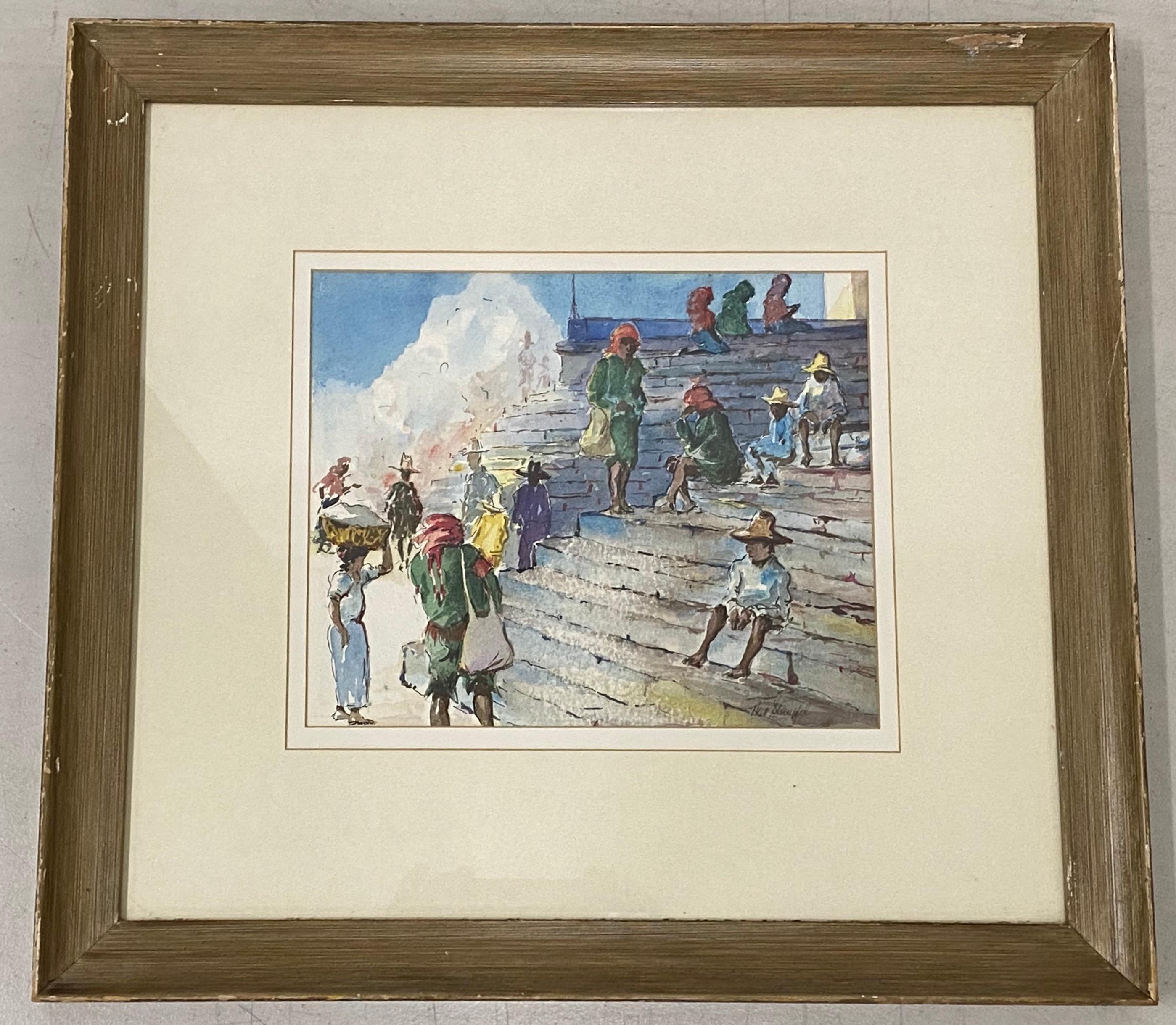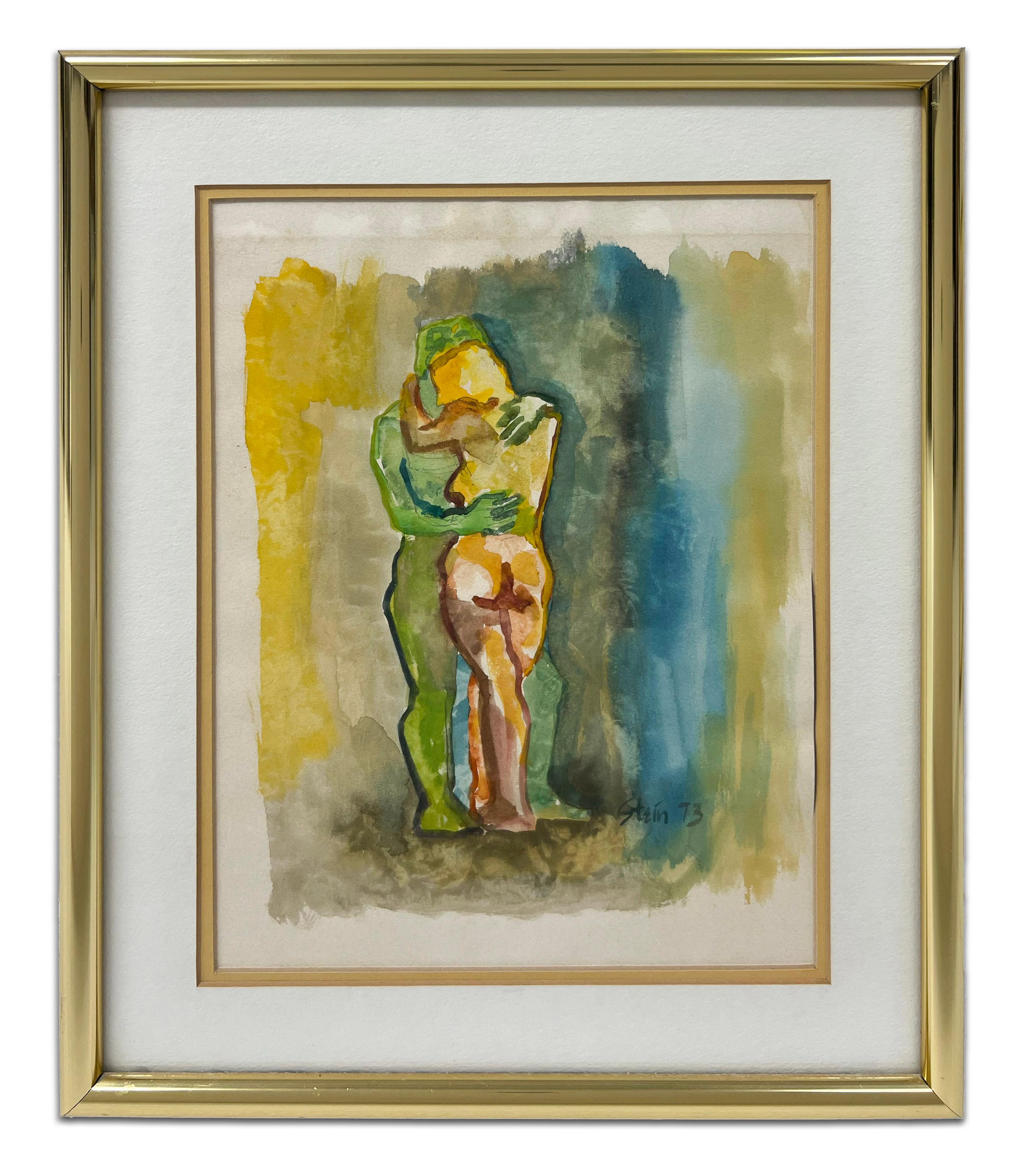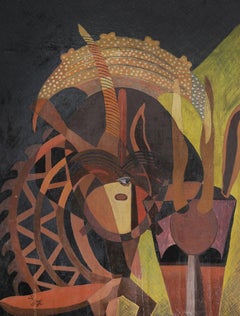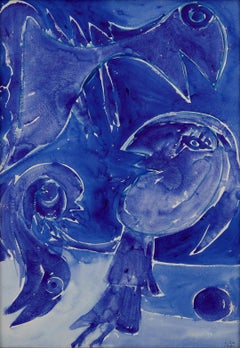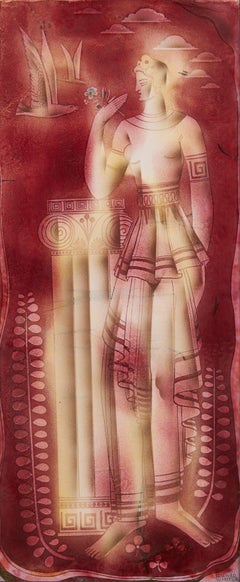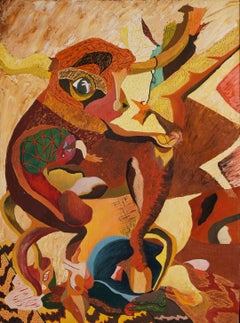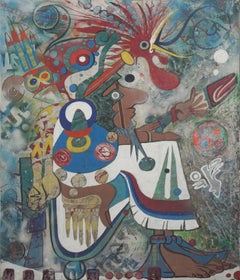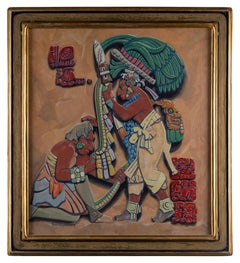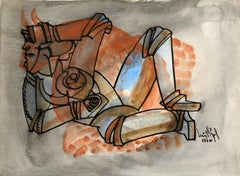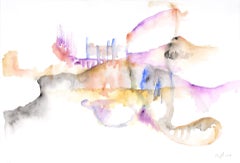Items Similar to Mayan, Large 20th Century Watercolor, Viktor Schreckengost
Want more images or videos?
Request additional images or videos from the seller
1 of 10
Viktor SchreckengostMayan, Large 20th Century Watercolor, Viktor Schreckengost
$6,500
£4,887.48
€5,675.55
CA$9,077.11
A$10,067.19
CHF 5,286.80
MX$123,632.26
NOK 66,925.81
SEK 63,111.93
DKK 42,345.81
Shipping
Retrieving quote...The 1stDibs Promise:
Authenticity Guarantee,
Money-Back Guarantee,
24-Hour Cancellation
About the Item
Viktor Schreckengost (American, 1906-2008)
Mayan
Watercolor heightened with gouache over pencil on paper
Signed lower right
39 x 29 inches
45.5 x 35.5 inches, framed
Registered with The Viktor Schreckengost foundation, stock no. 6891
The son of a commercial potter in Sebring, Ohio, Viktor Schreckengost learned the craft of sculpting in clay from his father. In the mid-1920s, he enrolled at the Cleveland School of Art (now the Cleveland Institute of Art, or CIA) to study cartoon making, but after seeing an exhibition at the Cleveland Museum of Art he changed his focus to ceramics. Upon graduation in 1929, he studied ceramics in Vienna, Austria, where he began to build a reputation, not only for his art, but also as a jazz saxophonist. A year later, at the age of 25, he became the youngest faculty member at the CIA. In 1931, Schreckengost won the first of several awards for excellence in ceramics at the Cleveland Museum of Art, and his works were shown at the Metropolitan Museum of Art, the Art Institute of Chicago, the Panama-Pacific Exposition in San Francisco, and elsewhere.
By the mid-1930s, Schreckengost had begun to pursue his interest in industrial design. For American Limoges, he created the first modern mass-produced dinnerware, called Americana. Along with engineer Ray Spiller, Schreckengost designed the first-cab-over-engine truck for Cleveland's White Motor Company. By the end of the decade, he had designed the first Mercury Bicycle for Murray, Ohio. In 1939, the bicycle and "The Four Elements" in clay were displayed at the New York World's Fair.
In the 1940s, Schreckengost's designs for children's pedal cars (as well as bicycles and toys) helped Murray, Ohio become the world's largest manufacturer of pedal cars. His design and ceramic work was interrupted by World War II, when he was recruited by the Navy to develop a system for radar recognition that won him the Secretary of Navy's commendation.
After the war, Schreckengost resumed his industrial design career creating products for Murray, Sears, General Electric, Salem China Company, and Harris Printing, among others. Approximately 100 million of his bicycles were manufactured by Murray, making it the largest bicycle-maker in the world. He retired from industrial design in 1972, but continued teaching at the Cleveland Institute of Art.
In Lakewood, Ohio, he is most famous for his creation of an architectural sculpture for the exterior of the Civic Auditorium at Lakewood High School, which opened in 1955. The Early Settler, commonly and wrongly referred to as Johnny Appleseed, was commissioned by the Lakewood Board of Education. (The Lakewood Observer. March 22, 2011)
Biography from the Archives of askART
In June, 2006, Viktor Schreckengost celebrated his 100th birthday in Cleveland Heights, Ohio. Of him at this event, it was written: Viktor Schreckengost, a prolific designer whose works ranging from toys, ceramics and paintings to dinnerware and trucks, have touched countless lives, expects his next inspiration to come at any time. . . (he) always seemed to know what to create by responding to needs---like improving the ride of a child's wagon or making user-friendly tableware with an artistic flair."
He said he was always focused on function and that when beginning a project, he would as himself the question: "What makes it happen, stand out?" He first considered form and then color and texture followed by, in his words, "all the other stuff added to it."
To recognize his birthday, more than 130 galleries and museums featured his work the summer of 2006 in a "National Centennial Exhibition" that paid tribute to his legacy that "includes generations of students who became designers who shaped the output of industrial America in the post World-War II era."
Earl Bateman, an associate of Schreckengost, said: "Everything he has done over his entire career has been part of the popular culture. His work spans so many styles. He didn't focus on being a fine artist but he created fine art."
In February 2008, Victor Schreckengost died at age 101 at Tallahassee, Florida, where he was spending the winter.
- Creator:Viktor Schreckengost (1906, American)
- Dimensions:Height: 45.5 in (115.57 cm)Width: 35.5 in (90.17 cm)
- Medium:
- Movement & Style:
- Period:
- Condition:
- Gallery Location:Beachwood, OH
- Reference Number:1stDibs: LU1768211939772
About the Seller
5.0
Vetted Professional Seller
Every seller passes strict standards for authenticity and reliability
Established in 1975
1stDibs seller since 2022
30 sales on 1stDibs
Typical response time: 2 hours
- ShippingRetrieving quote...Shipping from: Beachwood, OH
- Return Policy
Authenticity Guarantee
In the unlikely event there’s an issue with an item’s authenticity, contact us within 1 year for a full refund. DetailsMoney-Back Guarantee
If your item is not as described, is damaged in transit, or does not arrive, contact us within 7 days for a full refund. Details24-Hour Cancellation
You have a 24-hour grace period in which to reconsider your purchase, with no questions asked.Vetted Professional Sellers
Our world-class sellers must adhere to strict standards for service and quality, maintaining the integrity of our listings.Price-Match Guarantee
If you find that a seller listed the same item for a lower price elsewhere, we’ll match it.Trusted Global Delivery
Our best-in-class carrier network provides specialized shipping options worldwide, including custom delivery.More From This Seller
View AllMeditation on African Sculpture, mid-century figural abstract painting
By Beni E. Kosh
Located in Beachwood, OH
Beni E. Kosh/Charles Elmer Harris (American, 1917-1993)
Meditation on African Sculpture, 1957
Oil on found wood panel
Signed and dated lower left
20 x 15 inches
Charles Elmer Harris...
Category
1950s Modern Abstract Paintings
Materials
Oil
The Blue Earth II, CoBrA movement, Mid-20th Century Danish Watercolor
By Carl-Henning Pedersen
Located in Beachwood, OH
Carl-Henning Pedersen (Denmark, 1913 - 2007)
The Blue Earth II, 1971
Watercolor on paper
Signed and dated lower right, signed, dated and titled verso
30.5 x 21.5 inches
Carl-Henning Pedersen was born in Copenhagen in 1913. At an early age he began taking part in politics, first in the youth association of social democrats and later in the youth association of communists, which better suited his revolutionary activist nature against fascism. In 1933, he attended the public high school of Humblebaek where he met the painter Else Alfelt, who he would marry in 1934 and with whom he would have two daughters. For many years the family divided its time between Copenhagen and the city of Bovbjerg, located on the North Sea, where Carl and Else had a studio. Between 1935 and 1940, Pedersen started to sketch and paint.
He exhibited for the first time, together with his wife, in “Kunstnernes Efterårsudstilling” (The Artists' Fall Exhibition) in Copenhagen in 1936. Pedersen associated with the young painters close to abstract movements, and like them, worked under difficult conditions. He went to Paris in 1939, where he encountered the work of Picasso, Matisse and Chagall.
Between 1940 and 1945, he contributed to the journal Helhesten. In the same journal, Pedersen published the text "Arte astratta o arte immaginaria," that supplied the most complete and precise definition, up to that point, of the work principles of the young generation of painters, of which he was a part. This definition, in many ways, was close to that which would be the program of the group Cobra. Between 1945 and 1960, the Danish artists went abroad and, along with Dutch and Belgian artists, founded the group Cobra, which was active between 1948 and 1951. During this period in 1948, Pedersen participated in the Biennial of Venice. He exhibited extensively with Cobra in shows such as its first important show which was held at the Stedelijk Museum of Amsterdam in 1949, “International Experimental Art.” Afterwords, Pedersen distanced himself from the group and began to travel frequently. His destinations included Greece, Italy, France, Switzerland, Norway, Lapland, Iceland, Turkey, Nepal, and Jerusalem.
He received the Eckersberg Award in 1950 from the Royal Danish Academy of Art. In 1952, he participated in “Contemporary Drawings from 12 Countries, 1945/1952,” an exhibition held at the Toledo Museum of Art in Toledo, Ohio, the exhibition also traveled to other museums in the United States, while in 1955, he took part in the group exhibition “Expressionism 1900/1955,” at the Walker Art Center in Minneapolis (also a traveling exhibition throughout the United States).
He participated in the 1952, 1955, 1958, 1961, 1964, and 1967 editions of “The Pittsburgh International Exhibition of Contemporary Painting and Sculpture” at the Museum of Art of the Carnegie Institute in Pittsburgh. The same museum also honored him with solo exhibitions in 1961 and 1968. In 1966, he exhibited at the Solomon R. Guggenheim Museum of New York in the show “European Drawings” that also traveled to Hawaii, Canada, Argentina, and Germany. In 1967, he showed at the “2. Internationale der Zeichnung” in Darmstadt, and then in 1968, he participated in the Premio Marzotto and the “Exhibition of Expressionist Art after 1950” at the Kunstmuseum of Lucerne, which then toured in Romania, Australia, Belgium, and Finland.
Pedersen received the medal of Prince Eugen in 1980, and he participated in the exhibition “Danish Artists, Carl-Henning Pedersen, Else Alfelt, Egil Jacobsen...
Category
1970s Abstract Expressionist Figurative Drawings and Watercolors
Materials
Watercolor
Helen of Troy, Early 20th Century Enamel, Cleveland School Artist
Located in Beachwood, OH
Edward Winter (American, 1908-1976)
Helen of Troy, 1938
Enamel
Signed and dated lower right
43 x 18 inches
44.5 x 19.5 inches, framed
Exhibited: Cleveland Museum of Art, May Show 19...
Category
1930s Mixed Media
Materials
Enamel
20th C. Figurative Abstract Painting Cleveland School African American Artist
By Beni E. Kosh
Located in Beachwood, OH
Beni E. Kosh/Charles Elmer Harris (American, 1917-1993)
Untitled
Oil on canvas board
Estate stamped #611 verso
24 x 18 inches
Charles Elmer Harris was born in 1917 in Cleveland, Oh...
Category
20th Century American Modern Figurative Paintings
Materials
Oil
Cactus (Mexico), Early 20th Century Cubist Still Life by Woman Cleveland Artist
Located in Beachwood, OH
Clara Deike (American, 1881-1964)
Cactus (Mexico), 1930
Watercolor on paper
Signed lower right, titled and dated on label verso
15.25 x 13.25 inches
25 x 22.5 inches, framed
A gradu...
Category
1930s Cubist Still-life Drawings and Watercolors
Materials
Watercolor
Tyrannus, Early 20th Century painting of a dog, Cleveland School Artist
By William Sommer
Located in Beachwood, OH
William Sommer (American, 1867-1949)
Tyrannus, c. 1935
Watercolor and pen and ink on paper
Signed lower right
7.5 x 9.5 inches
16 x 18 inches, framed
William Sommer is seen as a ke...
Category
1930s American Modern Animal Drawings and Watercolors
Materials
Pen, Watercolor, Ink
You May Also Like
Mayan Inspired Abstracted Figurative
Located in Soquel, CA
Stunning contemporary painting of Mayan priest by bay area artist C. Udesen (American 20th C) with impressive costume surrounded with Mayan iconography in...
Category
Early 2000s Contemporary Figurative Paintings
Materials
Canvas, Oil
$3,200 Sale Price
20% Off
Mayan Chief Scene
Located in Sheffield, MA
Maurice Greenberg
American, 1893-1996
Mayan Chief Scene
Oil on canvas
22 ¾ by 26 ¾ in, w/ frame 29 by 32 ¼ in
Signed lower left
Maurice was born in Milwaukee, where he received his...
Category
Mid-20th Century Other Art Style Paintings
Materials
Oil
Luis Miguel Valdes, ¨Chac-1¨, 1996, Work on paper, 9.1x11.8 in
By Luis Miguel Valdes
Located in Miami, FL
Luis Miguel Valdes (Cuba, 1949)
'Chac-1-96', 1996
aquatint on paper
9.1 x 11.9 in. (23 x 30 cm.)
ID: 1D199601
Hand-signed by author
______________________________________________
Bio...
Category
1990s Contemporary Drawings and Watercolor Paintings
Materials
Paper, Ink, Aquatint
Roberto Marfil Mexican Artist 1997 Original Hand Signed watercolor
Located in Miami, FL
Roberto Marfil (Mexico, 1958)
'Medea', 1997
watercolor on paper
15.4 x 18.6 in. (39 x 47 cm.)
ID: MAR1213-002-001
Unframed
Hand-signed by author
Category
1990s Contemporary Prints and Multiples
Materials
Paper, Engraving, Screen, Watercolor
Vintage Latin American School Original Watercolor C.1960
Located in San Francisco, CA
Vintage Latin American School Original Watercolor C.1960
A fine watercolor signed in the lower right corner (illegible)
Watercolor dimensions 1...
Category
Mid-20th Century Figurative Drawings and Watercolors
Materials
Watercolor
Signed, Watercolor on Paper. Framed Painting - Figurations 359.007
Located in New York, NY
Linda Stein, Figurations 359.007 - Signed, Watercolor on Paper, Framed Painting
Linda Stein's Figurations series are early paintings she made in the 1970s. They
show the artist's p...
Category
1970s Contemporary Figurative Paintings
Materials
Paper, Watercolor
More Ways To Browse
Large Architectural Drawing
Vintage Bicycle Painting
General Electric Vintage
1940s Art Deco Drawing
Vintage Car Drawing
Mid Century Dinnerware
Mayan Sculpture
Limoges Framed
Limoges Art Deco
1940s Paintings Florida
Vintage Brown Dinnerware
Mayan Mid Century
Vintage Toys 1930s
American Limoges
Chinese Ceramic Children
Vintage General Electric Signs
Vintage White Dinnerware
Stuffed Toys
